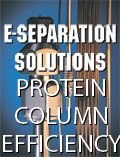Breaking Ground in Protein Column Efficiency with Slip Flow Technology
The HPLC 2012 conference was abuzz with talk of "slip flow" following the talk given by Mary Wirth of Purdue University about her groundbreaking work involving protein column efficiency. In this interview, Wirth explains how “slip flow†works and what this discovery can contribute to the application of LC-MS to disease research.
LCGC
recently spoke with Dr. Mary Wirth, the W. Brooks Fortune Distinguished Professor in the Department of Chemistry at Purdue University, about her groundbreaking work involving protein column efficiency. Wirth and colleagues guest authored the October installment of “Column Watch,” which explains how “slip flow” works and presents a practical example using this concept.
Your paper in the October issue of LCGC discusses the phenomenon of “slip flow.” What is slip flow?
Slip flow has the effect of flattening the parabolic flow profile to reduce band broadening. Slip flow is a nanoscale phenomenon that enhances the flow rate of a liquid when the interactions between the liquid and the walls are weak. Such weak interactions occur in reversed-phase liquid chromatography between polar solvents and hydrocarbon surfaces. Submicrometer particles have the nanoscale interstitial dimensions needed for significant slip flow.
Is this phenomenon important for separations of both proteins and small molecules?
Our present results point to importance for both. Proteins diffuse slowly, so the parabolic flow profile can impart quite a bit of broadening in conventional media, and slip flow reduces this broadening. The advantage is likely to extend to small molecules. These require smaller particles. We have preliminary results for particles as small as 110 nm in diameter showing very large flow enhancements, so the advance could eventually impact both small-molecule pharmaceuticals and protein separations.
What impact do you expect this discovery to have on the separations community?
People are interested in something new, so it will likely stimulate discussion and research, and enable new applications. Ultimately, new instrumentation will be needed to take full advantage of the narrower peaks from slip flow. Instruments always impart some broadening, so any advances in column efficiency necessitate advances in the instrumentation.
Your research web site says that you work at the interface of chemistry and medicine, with the goal of creating technology for earlier detection of disease. How does your work on slip flow fit into that vision?
Liquid chromatography (LC) already plays a role in biomarker detection for disease diagnostics, giving reproducible separations of proteins, peptides, and metabolites, all with mass spectrometry (MS) compatibility. Earlier detection of diseases requires higher sensitivity because aberrant species would generally be at lower concentration. Slip flow should increase sensitivity because narrower peaks mean more intense peaks. Also, in biomarker discovery, the complexity of biological samples is a challenge, so the higher resolution from slip flow ought to be a benefit as well. Finally, throughput has been a big limitation in biomarker discovery, and the higher speed should help throughput.
Have your collaborations with medical researchers and industrial scientists had an impact on the way you approach your research?
Yes! It is essential to talk with practitioners frequently because they know what the real problems are and they know what the real needs are. In academics, we are free to pursue a new discovery, and slip flow in chromatographic media is a good example of that. We have one foot in the nanofluidics world so that we can advance the understanding of the phenomenon of slip flow. We have the other foot in the medical world, where our discussions with clinicians and industrial scientists help us direct these advances toward real problems.
What research questions do you hope to answer in the next few years?
Since we have not optimized flow rate yet, we would like to know how far slip flow can be pushed in terms of plate numbers. We would also like to know how small the particles can be to address column capacity.
We are beginning to use a commercial nanoLC instrument. This will reveal how much benefit can be gained from existing instruments and what instrumental advances are needed to enjoy the full advantages of slip flow.
Since the peaks are so narrow, our published work used on-column detection of labeled proteins by fluorescence microscopy. We want to know if nanospray MS detection will preserve the high gain in column efficiency from slip flow.
Absorbance detectors are more common than MS, but they require a long pathlength, which would give enormous broadening for our capillaries. We would like to see if label-free, on-column detection can be done. This is possible because the submicrometer particles form colloidal crystals, and many publications have shown that colloidal crystals act as diffraction gratings, which are sensitive to the composition of the liquid inside. So it is conceivable that the absorbance detector can be avoided in general use.
Related content:
Study Explores Thin-Film Extraction of Biogenic Amines via HPLC-MS/MS
March 27th 2025Scientists from Tabriz University and the University of Tabriz explored cellulose acetate-UiO-66-COOH as an affordable coating sorbent for thin film extraction of biogenic amines from cheese and alcohol-free beverages using HPLC-MS/MS.







